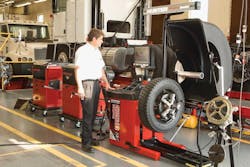Balancing starts with mounting
When it comes to achieving the correct balance on a medium truck tire and wheel assembly, it all starts with how you mount the assembly on your balancing machine.
“We say 60% of vibration issues in passenger car comebacks are related to mounting,” says Kevin Keefe, vice president of marketing for Hennessy Industries Inc. “Probably 80% to 85% in medium truck is related to mounting — it’s that big of a variable.
“The big challenge in medium- and heavy-duty balancing is not so much technique as it is the size and weight of those assemblies, which makes them very hard to mount and center on the balancer,” he continues.
“Using a conventional taper cone like you would for most hub-centered passenger car applications is very challenging. You’re fighting gravity the whole time.”
In any balancing application, the goal is to center the tire and wheel assembly on the balancer the same way it’s centered on the vehicle.
“Once you have ensured that you have centered (the assembly), then you can proceed with balancing similar to what you would do with a passenger car,” says Greg Meyer, product manager for balancers, Hunter Engineering Inc.
“The difference will be the types of weights you use. You’re dealing with larger weights than you are with a passenger tire. But the procedures for balancing are very similar to that of a passenger tire.”
Dynamic vs. static
Meyer says that when he tours commercial tire service centers, he sometimes finds that technicians “negate dynamic balancing. They will want to go static-only.
“A lot of people chase vibration issues; they can’t figure it out. And it turns out they have a very basic dynamic imbalance that was ignored during the balancing process.
“Sometimes they do this because of weight placement. A lot of these assemblies require a lot of weight” to achieve a traditional dynamic balance. “Just because it’s medium-duty, you can’t ignore dynamic forces.”
Keefe calls static balancing “the enemy” of truck tire and wheel assembly balancing. “We say that about passenger car balancing, but in heavy-duty applications it’s even more so because of the size and weights of the vehicles and the loads under which they tend to run.
“Vibrations that stem from a dynamic imbalance in those applications translate far less into a vibration or a wear condition.”
As in passenger tire and wheel balancing, it’s critical to take your time when balancing truck tire/wheel assemblies, according to Meyer.
“It’s not like a passenger tire shop where you’re running hundreds (of tire and wheel assemblies) a day. But I think that centering and balancing in medium-duty is more challenging. You need to focus your attention and make sure you are balancing the assembly properly.” ■
Total balance -- Don't forget the trailer tires
It may not be entirely right, but it’s a fact regardless: Balancing drive and steer tire and wheel assemblies often takes precedence over balancing trailer tire and wheel assemblies, according to Ian Savidge, marketing manager for M&R Tire Products. (The company produces and markets Magnum Plus truck tire balancing beads.)
While it’s important to make sure drive and steer tires are balanced properly, “the tire position we believe gives the most benefit by being balanced is the trailer position,” he says. “If not balanced, trailer tires are much more susceptible to tread scuffing and bumping. If the tire is balanced, you also get more pronounced tread life.”
Brian Hodge, marketing director for International Marketing Inc., which recently introduced its XACTBalance 180s product — a ring balancing system that attaches to the drop center of the wheel — says there is a “hierarchy” in truck tire balancing.
“Steer is number one on the list and drive is a distant second. The third would be trailer.”
It’s “very important” to balance drive tires, he explains, because “there are vibrations that end up in the steer axle that only start in the drive tires. But once customers start thinking about drive tires, it’s not hard to get them thinking about their trailer tires.”
At the end of the day, regardless of their position on a rig, all tire and wheel assemblies “should be balanced to increase tire life,” says Roger LeBlanc, president of Counteract Balancing Beads. “Tires last an average of 30% longer if you balance them.”
